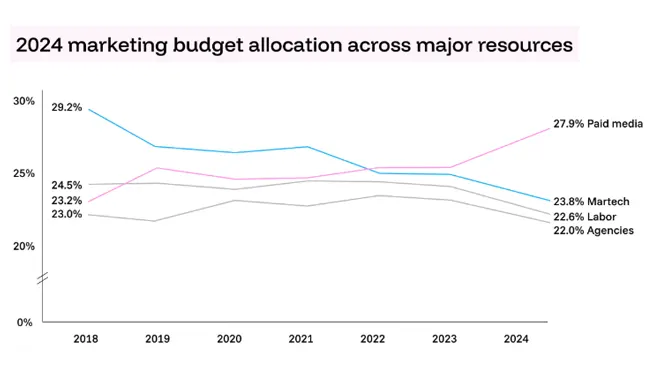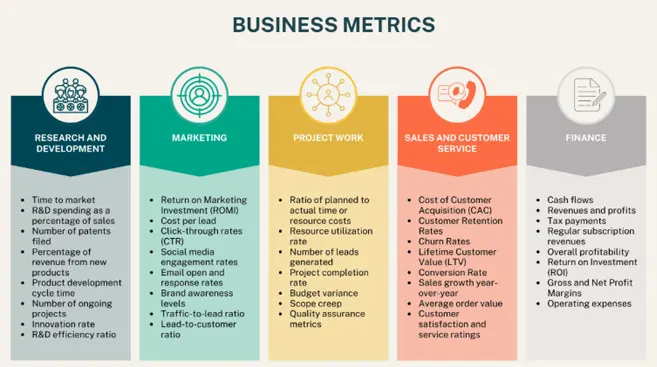
Although marketing budgets have decreased recently, expectations are still rising.
In order to increase overall performance, optimize campaigns, and improve customer care and experience, today’s marketers must do more with less.
When there is less money available, that is not a simple process. Therefore, now more than ever is the time for marketers to properly prepare their marketing budget!
In order to support paid efforts, you should think about which channels will yield marketing and company KPIs, which campaigns will increase brand awareness, drive traffic, or generate leads, and how to improve organic efforts.
Keep in mind that artificial intelligence (AI) can assist with budget planning in areas like audience targeting, market and competitor insights, forecasting, and scenario testing.
In this article, we’ll examine the state of marketing budgets and offer essential guidelines for creating and carrying out a budget that will support your objectives.
- How have marketing budgets changed?
- 8 Steps to Plan Your Digital Marketing Budget
- Evaluate past performance
- Set clear goals
- Allocate budget based on success
- Break down your requirements
- Plan your content creation
- Choose your platforms
- Monitor your results
- Look to the future
How have marketing budgets changed?
The CMO Spend Survey from Gartner indicates that there have been significant changes in marketing budgets in recent years. Budgets accounted for 11% of total corporate revenue in 2020, but during the peak of the COVID-19 epidemic in 2021, they dropped to 6.4%. In 2022 and 2023, they recovered to over 9% of revenue, but in 2024, they fell 15%, from 9.1% to 7.7%.

Gartner’s 2024 CMO Spend Survey indicates that marketing budgets have decreased by 15%, from 9.1% of corporate revenue in 2023 to 7.7% in 2024. With technology investments at their lowest level in ten years, this fall is ascribed to lower spending on people, agencies, and marketing technology (martech). In contrast, investments in paid media have grown, making for 27.9% of the budget in 2024. “
In this budget-constrained environment, increasing return on investment (ROI) has emerged as a top priority for marketers. 20% of senior marketers say that improving ROI is their biggest challenge, according to the Digital Marketing Institute. “
An emerging possible remedy for marketing budget optimization is artificial intelligence (AI). Marketers can embrace a precision mindset by investing in AI solutions that automate tedious activities, use predictive analytics to forecast campaign results, and allocate resources based on real-time data insights, suggests Mischa McInerney, CMO of the Digital Marketing Institute. In order to prioritize channels and strategies with a shown return on investment and cut down on expenditure in areas that aren’t performing up to par, she stresses the significance of testing, learning, and iterating rapidly.
8 Steps to Plan Your Digital Marketing Budget
Creating a strategy plan that supports departmental and organizational goals is crucial to efficiently maximizing your marketing budget. Start by carefully analyzing previous marketing campaigns to determine which platforms and strategies produced the best outcomes. By concentrating on tactics that increase revenue generation, brand awareness, and conversion rates, this analysis helps you to deploy resources more effectively. You can make sure that every expense makes a significant contribution to your overall business objectives by basing your budget decisions on data-driven insights.
Let’s examine eight essential actions that will assist you in creating a solid and practical marketing budget.
1) Evaluate past performance
It’s critical to examine prior success by examining paid media, marketing campaigns, attribution models (which analyze how marketing approaches contribute to sales, conversions, or other targets), and different channels in order to manage your marketing budget effectively. In order to determine which investments are promoting sustainable growth over the long and short terms, this review looks at important efficiency criteria.
Emily Kramer provides a thorough analysis of key efficiency indicators, such as the lifetime value to customer acquisition cost (LTV:CAC) ratio, payback period, and customer acquisition cost (CAC) ratio. These indicators help you allocate your spending wisely and offer insightful information about how well your marketing efforts are working. You can consult her primer on the topic for a thorough explanation of these indicators and how they are calculated.

Analyzing historical performance through an examination of both offline and online digital channels is essential to making the most of your marketing spend. This study assists in identifying effective methods and comprehending the factors that contribute to their efficacy, as well as identifying underperforming areas and identifying the reasons behind them. Refining future marketing efforts requires understanding what worked, what didn’t, and why.
AI-Powered Resources to Help Assess Historical Performance:
Google Looker: Offers extensive reporting and data visualization features that allow for a thorough assessment of campaign effectiveness.
Mixpanel: Offers insights into consumer journeys and interactions with your brand, with a focus on user behavior analytics.
Domo: Allows for a comprehensive evaluation of performance across numerous channels by integrating data from multiple sources.
2) Set clear goals
One of the most important steps in creating a successful digital marketing budget is setting clear, precise targets. In addition to saving money, avoiding a scattergun strategy guarantees that your marketing initiatives are strategically in line with your company’s goals.
Start by deciding what your main goal is, whether it’s raising revenue, lead generation, or brand exposure. Establish secondary and tertiary objectives that complement this primary goal next. Your marketing efforts will have a clear direction thanks to this hierarchical goal structure, which also makes it easier to allocate your cash to the most effective channels and strategies.
You may measure progress and make required adjustments by establishing clear goals that serve as a blueprint for your marketing plan.
But in every situation, you need to be aware of your goals, such as these ones:
- Increase exposure of your brand
- Increase brand loyalty
- Produce more superior leads
- Boost income
- Increase the rate of conversions
Your budget allocation will be significantly impacted by the objectives you choose for your plan, such as increasing sales, generating leads, or raising brand awareness. Each of these objectives calls for a different approach. Because they will have a direct impact on the channels you prioritize, the strategies you use, and the resources you allot, it is crucial to clearly define your objectives.
AI techniques for establishing precise financial objectives
Funnel.io: combines marketing data to help with performance monitoring and goal-setting.
Klipfolio: aids in the creation of dashboards to track progress and match objectives with KPIs.
Databox: tracks goals automatically and offers information on how to modify tactics to achieve goals.
3) Allocate budget based on success
You can begin segmenting your budget according to priorities and success after you have a goal and a sense of what has and has not been working.
Here, “success,” not “cost,” is the crucial term. Understanding what has worked across your owned, earned, and paid media can be aided by the actions you’ve made to examine historical performance and compute analytics.
For instance, if you depend on natural posts and traffic, social media marketing could not really cost you anything.
However, you could wish to allocate some funds to social media in order to try influencer marketing or paid advertising if an examination of your previous digital marketing initiatives reveals that Instagram is successful in increasing brand recognition.
After all, if Instagram works for you without a strategy or a lot of posts, think about how much more efficient it could be if you have a social media manager or the appropriate software and tools to make the most of it.
Neil Patel Digital conducted a poll to examine 2025 marketing budgets for social media advertising across networks. It’s interesting to note that, at 49% and 55%, respectively, YouTube and X appear to be receiving the largest budget increases, while Facebook may only get a 14% increase.
Even with a limited budget, don’t rely just on one channel; instead, consider alternative areas that you could be underutilizing but that could yield success.
One strategy that can significantly increase the visibility of your brand and content is search engine optimization, or SEO. Should you purchase any tools to improve your SEO, or should you sign up for a platform to maximize keyword research?
Move the budget to something that produces higher outcomes and go where the action is.
AI-powered technologies to assist with budget allocation
Singular: monitors ROI across channels and automatically allots funds according to performance.
Madgicx: evaluates the effectiveness of advertising campaigns and makes dynamic budget reallocations.
Allocadia: Focuses on marketing budget planning and goal-aligning expenditures.
4) Break down your requirements
It’s time to allocate your budget for the particular resources you’ll require now that you have a clearer understanding of your objectives and the strategies and platforms you intend to employ to get them.
Naturally, digital marketing involves combining two different resources: resources and tools/software. You must begin examining how your personal budget can support these.
Take your paid advertising, for instance. Do you wish to spend money on tried-and-true strategies like pay-per-click advertising? After all, according to Hubspot’s Annual State of Marketing Report, 63% of people have clicked on a Google ad. Or, considering the success of your organic social initiatives, would you like to attempt paid social?
Consider your available resources for running sponsored campaigns. Do you want one person to manage all paid marketing, or do you want a dedicated team member for each? If there is only one, how much time and what equipment should that person devote to it?
Other areas to think about that will require budget are:
- Content: Developing an effective strategy.
- Creative: Freelancers or building an in-house.
- Social media: Organic and paid marketing is crucial for developing an effective marketing strategy.
- Email marketing: Management of platforms and lists
- Conversion Rate Optimization (CRO) and user experience (UX): Structure, expenses, and tools of a website
- Traditional advertising: Radio, television, or print
- PR or Events: Location, operating expenses, and advertising
- Technology and tools licences: Location, operating expenses, and advertising
- Community management: Overseeing communities and groups on social media and other platforms, as well as outreach
AI tools to help you break down requirements
- Asana (with AI features): aids in resource allocation and organization for marketing initiatives.
- Monday.com: provides workload management powered by AI to maximize teamwork.
- Smartsheet: oversees the budget, schedule, and resources for marketing initiatives.
5) Plan your content creation
In order to draw in, influence, and convert consumers, marketers must constantly create and generate content (under the direction of a sound content marketing strategy).
Your audience’s tastes, marketing goals, and company model should all be reflected in the material you provide. Creating in-depth case studies, whitepapers, and thorough blogs can help service-oriented businesses build industry authority and educate their audience. To produce high-quality content, it could be required to set aside money for subject matter specialists or to use a guest blogging strategy.
On the other hand, visual content like films may increase engagement for product-based firms, especially on social media. Budgeting for recording gear, editing software, and possibly employing writers or presenters are all necessary for this strategy. Making listicle-style blogs and infographics can also be helpful at different points in the sales funnel.
It’s crucial to take into account how the field of content discovery is changing as a result of advances in artificial intelligence. For example, Google’s AI Overviews, which offer AI-generated summaries with important details and connections for further investigation, are revolutionizing the way people find information. You may increase the visibility of your content by comprehending and adjusting to these changes. Additionally, service-based businesses shouldn’t undervalue the possibilities of platforms like TikTok or short-form films. Shopify, for instance, has effectively used TikTok to interact with its audience on occasions such as Black Friday. These tactics might help you reach a wider audience and vary your content strategy.
AI tools to help with content creation
Claude, ChatGPT, Jasper, and Gemini: Great artificial intelligence tools for content creation and copywriting.
Canva’s AI features: makes it easier to create graphics and images for marketing
Descript: simplifies editing and transcription for the creation of audio and video.
6) Choose your platforms
Examining the platforms you decide to employ is another crucial aspect of your budget. Your company and the market you serve will have a big impact on this.
You must make sure that your platform budget is well-rounded and effective, which may involve the following:
1. Advertising Platforms
- Google Ads and Microsoft Ads are examples of search https://www.hooghlyinfotech.com/google-ads/engine advertising.
- Facebook, Instagram, X, LinkedIn, TikTok, and Pinterest are examples of social media advertising.
- Display advertising options include native ads (like Taboola and Outbrain), programmatic platforms, and Google Display Network.
- YouTube, TikTok, or social media video campaigns are examples of video advertising.
2. Content Creation
- Design, photo editing, and animation: stock photo licensing, Photoshop, Illustrator, and InDesign.
- Project administration: Asana, Basecamp
- TrackMaven Analytics
- Hosting webinars: Zoom, BigMarker
- Streaming podcasts: Riverside.fm
- Camtasia and Premiere for creating and editing videos
- Vimeo is the video hosting platform.
- Research resources and AI content: ChatGPT, Jasper, Claude
- Platforms for marketing automation: Marketo and Hubspot
3. SEO
- Moz, SEMrush, and Ahrefs
4. Social Media Management
- Tools for scheduling and tracking: Sprout Social, Buffer, or Hootsuite
5. Email Marketing
- HubSpot, Klaviyo, ActiveCampaign, or Mailchimp are examples of email platforms.
- Platforms for marketing automation: Pardot, Marketo, and others.
6. Analytics and Reporting
- HubSpot, Data Studio, and Google Analytics.
7. E-commerce Tools
- Using Instagram Shop or Google Shopping for shopping advertisements
- Tools for managing product feeds
8. Competitor Analysis
- Platforms like SpyFu, SimilarWeb, or social media analytics
7) Monitor your results
Tracking important indicators can help you evaluate the return on investment (ROI) and make sure your expenditure is in line with your company’s objectives.
Equipped with well-defined objectives and key performance indicators (KPIs) from step 1 above, you may compare campaign and channel performance.
Track performance metrics like CPL, conversion rates, and CAC via analytics tools like Google Analytics, CRM platforms, or social media insights.
To find areas of underperformance or excessive spending, compare these KPIs on a regular basis with the amount allotted in your budget. Last but not least, carry out routine evaluations to improve your approach and reallocate funding to the most successful campaigns and channels.
AI tools to help monitor results
HubSpot: uses integrated CRM and analytics to monitor campaign performance.
Supermetrics: gathers and compiles data from several platforms into a single dashboard for analysis.
8) Look to the future
Building on previously effective marketing strategies is important, but it’s also critical to keep an eye on new trends. Your company will stay up to date on new chances if you designate specialised team members or experts to keep an eye on advancements in digital marketing. Early adoption of innovations can give you a big competitive advantage since it makes your brand stand out and attracts the interest of your target market.
For example, data analysis, consumer engagement, and content development have all been transformed by the use of artificial intelligence (AI) in digital marketing. AI solutions can improve overall productivity by providing predictive data, automating tasks, and personalising marketing campaigns.
Furthermore, the marketing landscape is changing due to developments in search engine optimisation (SEO) platforms and advertising techniques, such as AI-driven creative workflows and the focus on first-party data. By keeping up with these developments, your company can adjust and prosper in a changing environment.
In conclusion, your company can be positioned for long-term success in the rapidly changing digital landscape by proactively observing and implementing cutting-edge marketing tools and tactics.
AI tools to help keep an eye on trends
Trend.io: keeps an eye on new developments in the sector and marketing trends.
Zyro AI Website Builder: uses AI-driven web development to assist in adapting to changing digital needs.
Futurepedia: A list of the newest AI products that will help marketers remain on top of developments.
Become a digital marketing expert
The secret to a successful business is knowing your target market and audience. You will get the ability to effectively lead and plan, use search marketing to increase sales, become more proficient in social media marketing, and investigate cutting-edge methods for delivering flawless customer experiences with our Certified Advanced Digital Marketing course. Enrol right away!

